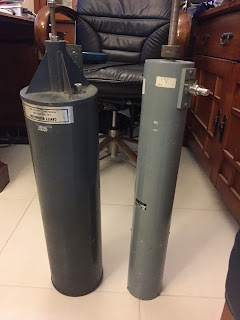Cavity resonators; size does matter and preview of my HP 8591A spectrum analyzer
Cavity resonators; size does matter and preview of my HP 8591A spectrum analyzer
The Q or quality of a cavity resonator or filter is critical. The simplest way of increasing Q is to increase the diameter.
The club has been lent what seemed a pretty ordinary 2 m cavity resonator; even has UHF rather than N connectors and is light. I wasn't expecting too much. But it is 150 mm diameter compared to the 100 mm ex-government cavity filters the club has.
The two cavity filters. Note that the filters are not tuned to the same frequency; but they are not too far apart to make a difference to Q.
However, what a difference size makes! The Q is visibly much better. Note, none of the instruments were calibrated for this exercise, it is just to show the qualitative difference.
First, the quick and dirty antenna analyzer and a 50 Ohm terminator.
Then with the club's Rigol spectrum analyzer.
Then with my recently acquired HP 8591A spectrum analyzer; 1990s' technology, 10+ kg but half the price of the Rigol. Even had to read the manual on how to use the tracking generator! All the same, it works quite well.
Then with my Chinese KC901H "RF multi-meter". These are are a neat device, with a new improved version out (and twice the $600 approx that I paid.)
The KC901H as an antenna analyzer with 50 Ohm termination on one side of each cavity.
Both filters are presumably made of silver-plated brass sheet. The diameter of the larger one is only 50 percent bigger, as is the surface area, but what a difference that seems to make to Q. Without chasing the relationship of Q to diameter, it seems more than linear. I shall try to find out, as I thought it was linear.
There may be another explanation due to the construction of the filter, but I can't see inside the bigger filter. It may have a larger diameter antenna or probe, as the ratio of the two diameters affects Q and impedance.
The Q or quality of a cavity resonator or filter is critical. The simplest way of increasing Q is to increase the diameter.
The club has been lent what seemed a pretty ordinary 2 m cavity resonator; even has UHF rather than N connectors and is light. I wasn't expecting too much. But it is 150 mm diameter compared to the 100 mm ex-government cavity filters the club has.
The two cavity filters. Note that the filters are not tuned to the same frequency; but they are not too far apart to make a difference to Q.
However, what a difference size makes! The Q is visibly much better. Note, none of the instruments were calibrated for this exercise, it is just to show the qualitative difference.
First, the quick and dirty antenna analyzer and a 50 Ohm terminator.
Then with the club's Rigol spectrum analyzer.
Then with my recently acquired HP 8591A spectrum analyzer; 1990s' technology, 10+ kg but half the price of the Rigol. Even had to read the manual on how to use the tracking generator! All the same, it works quite well.
Then with my Chinese KC901H "RF multi-meter". These are are a neat device, with a new improved version out (and twice the $600 approx that I paid.)
The KC901H as an antenna analyzer with 50 Ohm termination on one side of each cavity.
Both filters are presumably made of silver-plated brass sheet. The diameter of the larger one is only 50 percent bigger, as is the surface area, but what a difference that seems to make to Q. Without chasing the relationship of Q to diameter, it seems more than linear. I shall try to find out, as I thought it was linear.
There may be another explanation due to the construction of the filter, but I can't see inside the bigger filter. It may have a larger diameter antenna or probe, as the ratio of the two diameters affects Q and impedance.












Comments
Post a Comment